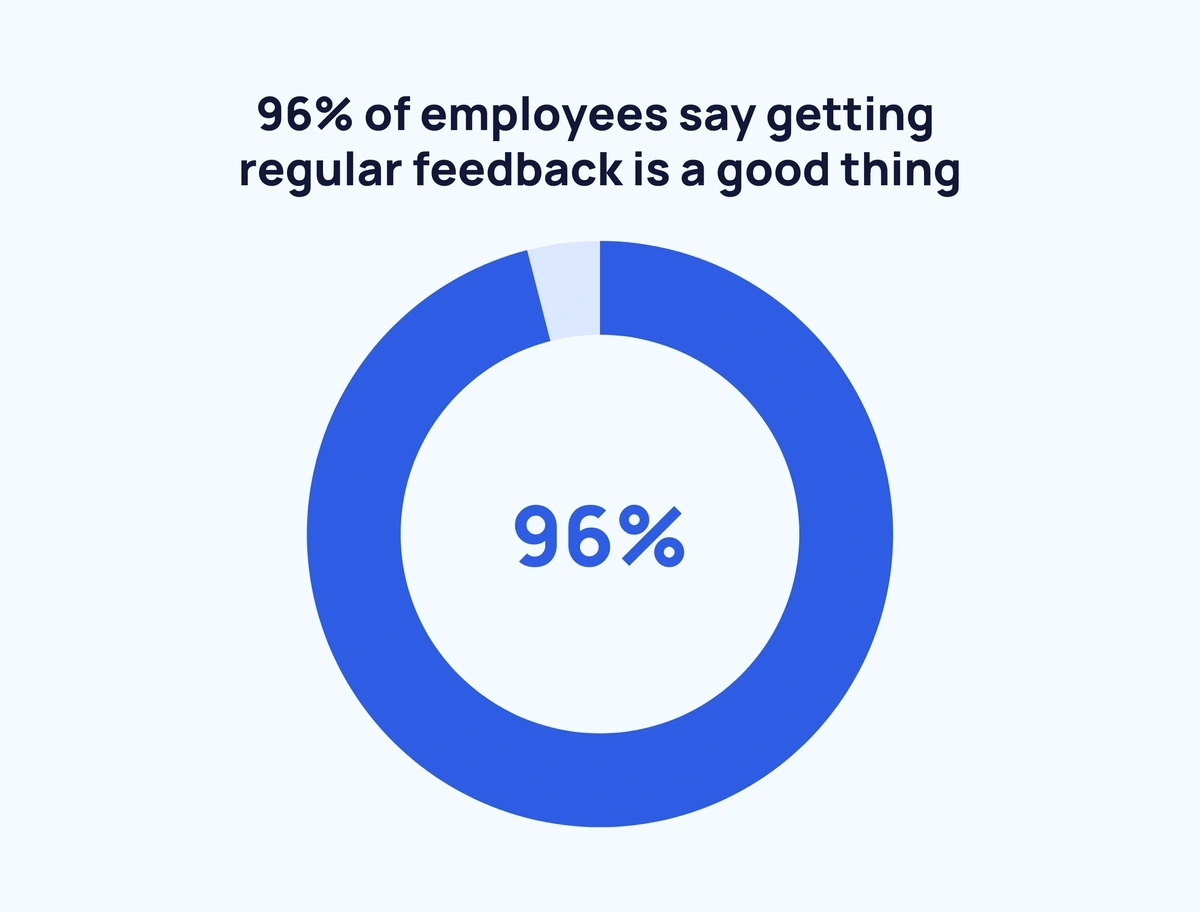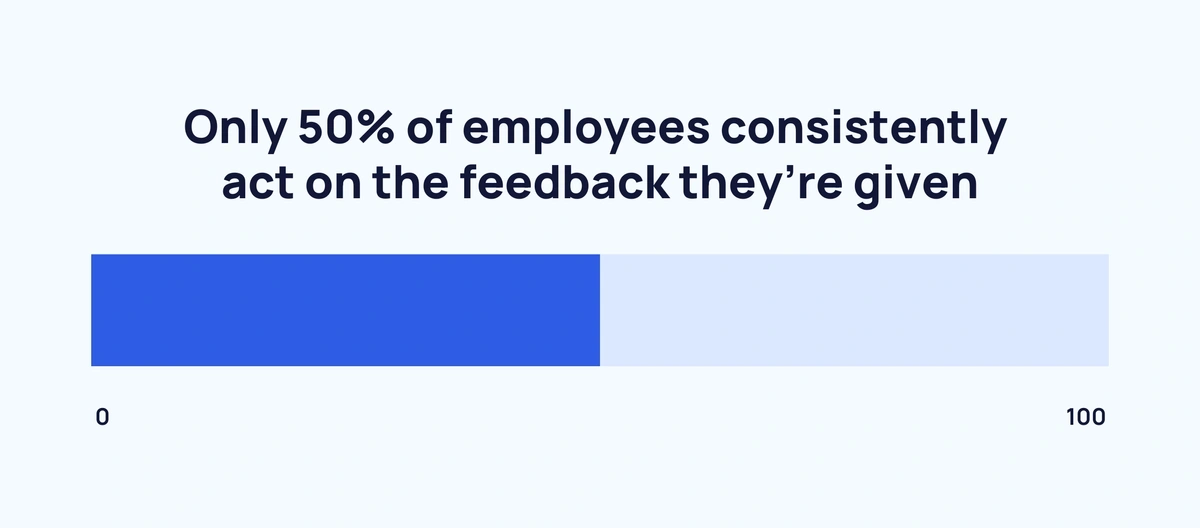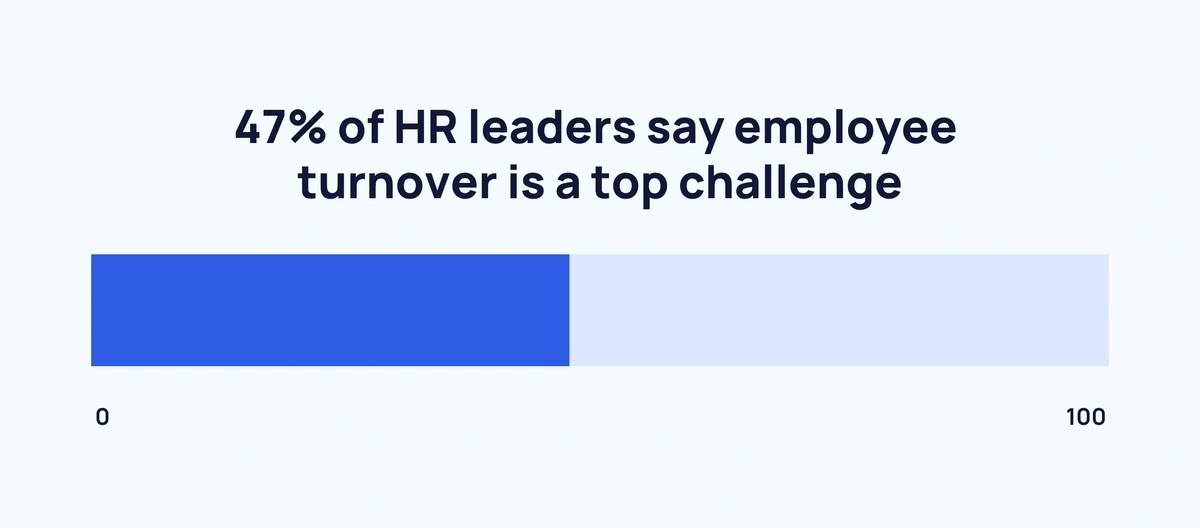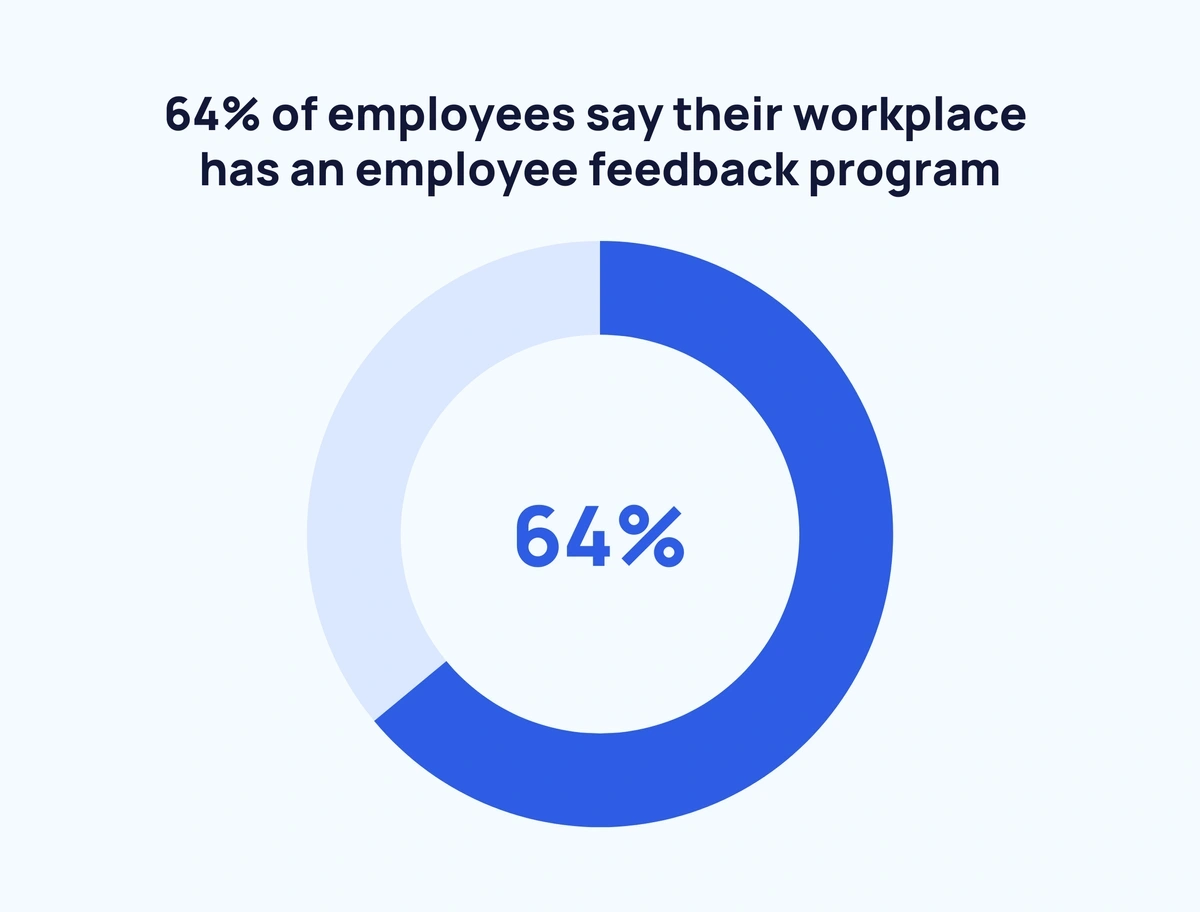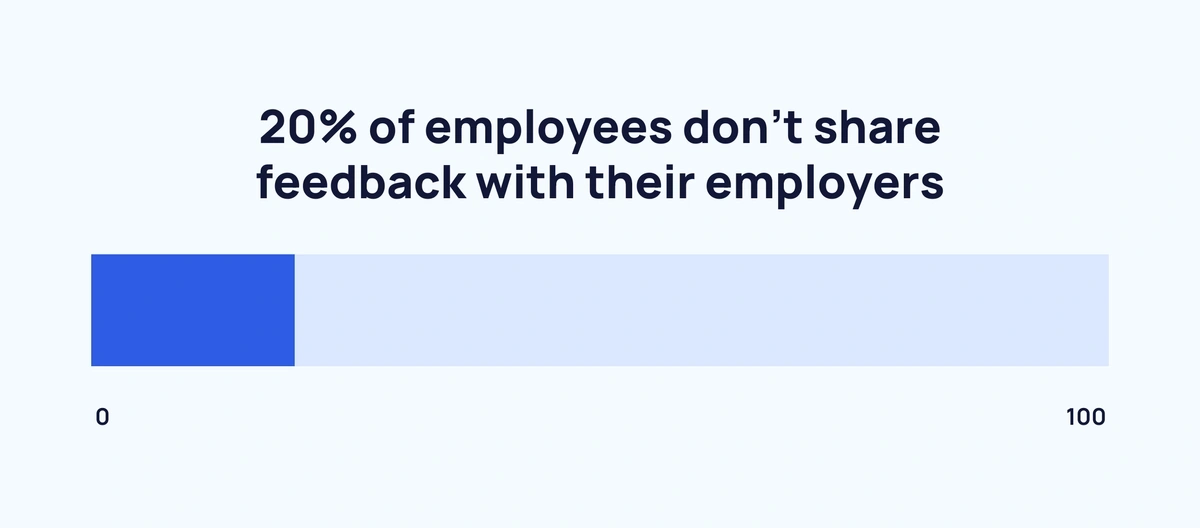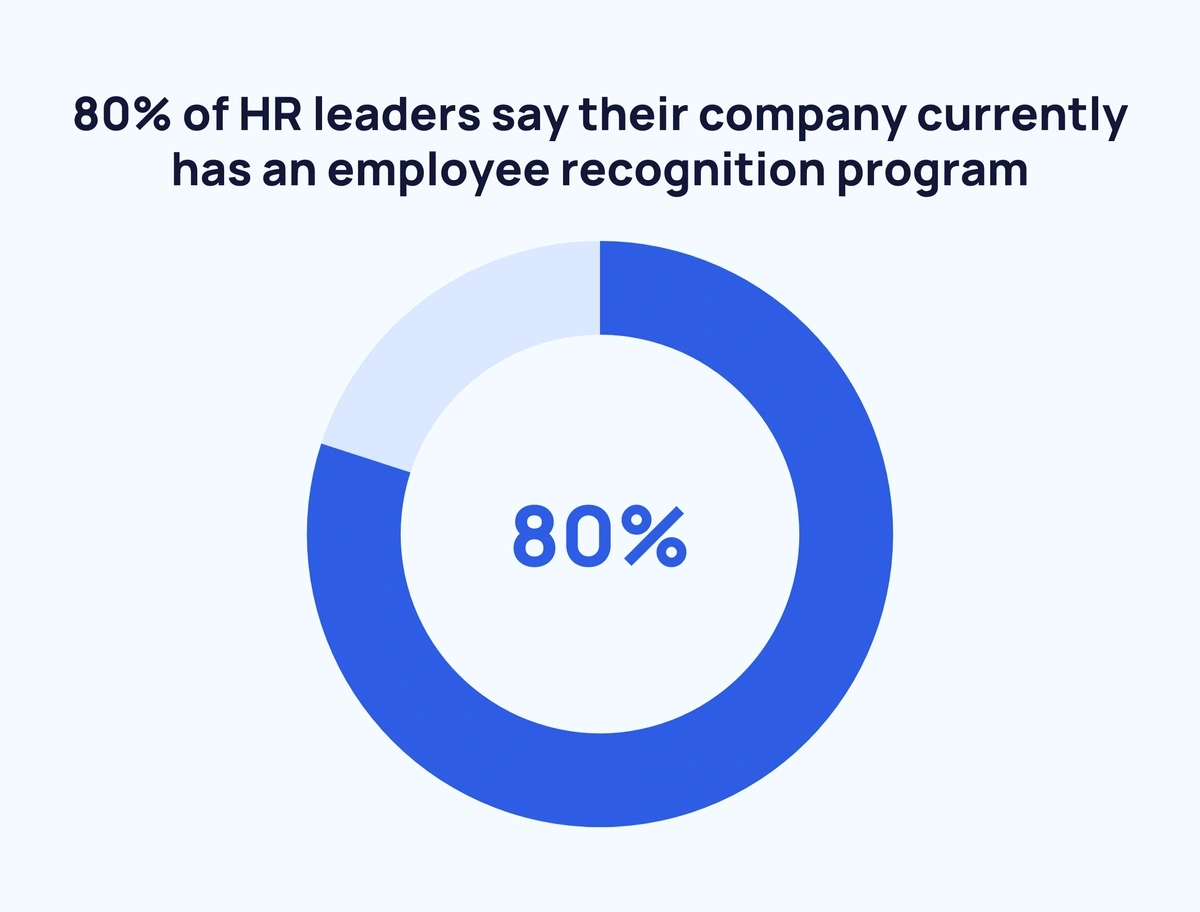
32+ Employee Feedback Statistics (2024)
The data is clear: employees crave feedback.
When managers give regular feedback to their employees, they create a culture that pushes everyone to do their best work. Why? Feedback shows workers that their talents and efforts are making a difference.
However, managers shouldn’t just be focused on giving feedback. They should be open to receiving it too. Open-door policies encourage employees to speak up about issues in the workplace and offer creative solutions.
In this report, you’ll learn how employee feedback — both to and from managers — affects workplace engagement, productivity, and morale.
Top Employee Feedback Statistics
Before you jump into the full report, take a look at these top employee feedback stats:
- 96% of employees say getting regular feedback is a good thing.
- Employees who receive recognition from management are 69% more likely to do better work.
- 64% of employees say their workplace has an employee feedback program.
- 41% of employees have left a job because they felt they weren’t listened to.
- 20% of employees don’t share feedback with employers.
- Only 10% of employees say they’re engaged after receiving negative feedback.
Manager to Employee Feedback
Giving just the right amount of feedback is critical. Too little feedback leaves employees wondering if their efforts are actually appreciated. Too much can make them feel micromanaged.
24 in 25 employees say getting regular feedback is a good thing (OfficeVibe)
Employees crave feedback on an ongoing basis. 32% of employees, however, say they have to wait three months or more to receive feedback.
What’s stopping management from upping feedback frequency? Some managers might hold back critical feedback out of fear of offending employees, but 83% of employees say they appreciate all kinds of feedback — positive or otherwise.
Managers who give just the right amount of feedback are the highest rated by employees (Predictive Index)
Can too much feedback be just as frustrating to employees as too little feedback? It turns out there’s a sweet spot to giving feedback in the workplace.
Over 5,000 employees were asked to share how much feedback they receive as well as rate their manager on a 1-10 scale. Respondents who felt their manager gave “just the right amount” of feedback rated their managers 8.6 on average. Those who got no feedback at all gave their managers a 4.2 rating, while those who received way too much feedback gave their managers a 4.5.
Only half of employees consistently act on the feedback they’re given (OfficeVibe)
Giving feedback doesn’t guarantee changes, but it can help. When asked if employees acted on their feedback, 50% of managers said yes, 28% said “not consistently,” and 22% said no.
Just 15% of employees believe their organization always shares the challenges facing it (LeadershipIQ)
When it comes to sharing organizational challenges, some companies are more open than others. 21% of employees say their company never shares the challenges facing it, while another 21% say it happens rarely. That lack of openness could affect organizations’ future hires.
Of the employees who say their company always shares its challenges, 63% said they would strongly recommend their company as a great place to work. Only 6% of employees who say their company never shares its challenges would give the same recommendation.
Employee Feedback, Engagement, and Turnover
Employees and managers alike agree that regular, constructive feedback is a positive thing. But what are the consequences of feedback (or lack thereof) on employee morale? Does the quality and quantity of feedback affect turnover rates? This section explores how feedback relates to employee engagement and retention.
“Fast feedback” can boost employee engagement by nearly four times (Gallup)
Feedback doesn’t have to occur at scheduled intervals. Effective managers share feedback in the moment — an approach called “fast feedback”. It’s a more organic and immediate way to communicate with workers.
84% of employees who received fast feedback said they were engaged in their work, compared to 15% who said they were not engaged.
Only 22% of employees who received no feedback over the past week said they were engaged, compared to 58% who said they were not engaged. Moreover, 19% of employees who received zero feedback said they were actively disengaged.
Only 10% of employees say they’re engaged after receiving negative feedback (Gallup)
When feedback causes employees to experience negative feelings, it can have an adverse effect on engagement. Negative feedback can also lead to employees seeking out other opportunities. 80% of employees who receive negative feedback are either actively or passively looking for another job.
75% of disengaged workers say poor relationships with management contribute to their lack of engagement (OfficeVibe)
Engagement suffers when there’s a disconnect between management and employees. But what exactly are employees looking for from their managers?
75% say they don’t receive feedback frequently enough to improve their work performance. 73% say they’d like their manager to be more clear with goals and expectations. 70% say they’d like to spend more time with their manager.
Almost half of HR leaders say employee turnover is a top challenge (Workhuman)
Of all the challenges HR professionals face, retaining talent is at the top of the list—more so than recruiting or cultivating workplace culture. While employees leave their jobs for countless reasons, HR leaders find that feedback and recognition are critical to employee retention.
41% of employees have left a job because they felt they weren’t listened to (AllVoices)
Employees can get itchy feet then they feel the feedback they give has no impact. The likelihood of leaving for feedback-related reasons increases with tenure: 36.7% of entry-level employees left their jobs vs. 46.5% of senior-level employees.
Issues can also arise when employee feedback is listened to but actually considered. 37% of employees say they’ve quit their jobs over feedback not getting taken seriously. Another 20% have considered leaving for the same reasons.
Companies that conduct regular strength-based feedback can reduce turnover by 14.9% (Gallup)
Employees who receive frequent recognition for their strengths tend to stick around longer. They also make for more productive workers. Gallup research found that teams that receive strength-based feedback were 12.5% more productive than those who received no feedback at all.
Employee Feedback Programs
There are two kinds of employee feedback: feedback given to employees by managers and supervisors, and feedback from employees. This section covers the current state of employee feedback programs, where workers can share their opinions on their organizations’ leadership and culture.
Around 2 in 3 employees say their workplace has an employee feedback program (AllVoices)
Just under two-thirds of employees have a platform to share their feedback about their company. 25% of employees say their organization doesn’t have a feedback program in place, and 12% say they’re not sure.
In-person feedback during team meetings is the most common type of employee feedback program (AllVoices)
55% of employees say their management team encourages in-person feedback during regular meetings. Other organizations use more formal methods for employee feedback programs.
47% run bi-annual employee feedback surveys, 36% use frequent pulse surveys, and 31% use digital suggestion boxes.
Employers that solicit employee feedback tend to ask once per month or quarter (AllVoices)
How often do employers ask for feedback? Here’s a breakdown from AllVoices’ survey of 817 employees:
- 23.7% ask for feedback once per month.
- 23.5% ask once per quarter.
- 20.3% ask weekly.
- 19.3% ask once per year.
- 13.1% never ask for employee feedback.
1 in 5 employees don’t share feedback with their employers (AllVoices)
Most employees take advantage of employee feedback programs, but one in five choose to remain silent. Of those who haven’t shared feedback, 30.7% say it’s because they didn’t have any feedback to share. Another 21% say it’s because they felt their feedback wasn’t important enough to share.
Other reasons for not sharing feedback are more concerning. 17.1% of employees say they have doubts about confidentiality when sharing feedback. 14.1% say they don’t share because they think nothing will be done to address their concerns. 12.2% don’t share because they're afraid of repercussions.
Improving morale is the most common topic brought up during employee feedback (AllVoices)
When asked what topics they bring up when giving feedback, 42.7% of employees mention improving morale. Other frequent feedback topics include mentioning positive things about coworkers (41.8%), concerns about workload (37.3%), company culture (32.8%), and workplace safety (31.9%).
Employee Recognition Programs
Feedback is — for the most part — a one-to-one exchange. Recognizing employee milestones and accomplishments in front of their peers can also help build strong company cultures. Here’s the state of employee recognition programs in 2024.
4 in 5 HR leaders say their company currently has an employee recognition program (Workhuman)
Four out of five organizations have a formal employee recognition program. According to HR professionals, recognition programs have a positive impact on employee experience (89%), employee relationships (86%), organizational culture (85%), employee engagement (84%), and organizational values (84%).
Just one-third of US workers say they received recognition for doing good work over the past week (Gallup)
While most companies claim to have an employee recognition program in place, many employees feel they don’t receive enough recognition. But recognition can have a positive, lasting effect on employees.
When asked who gave them the most memorable recognition, 28% of employees said their manager while 24% said recognition came from a high-level executive. Recognition from customers (10%) and co-workers (9%) is often less memorable.
Employees who receive recognition from management are 69% more likely to do better work (GreatPlaceToWork)
Recognition helps motivate. 37% of employees say they’d be motivated to do better work if they felt recognized by management. Those employees consider recognition a stronger motivator than inspiration, autonomy, promotions, and pay raises.
Recognition can also boost morale, enhance creativity, and improve company culture.
Great Place To Work found that employees who feel the most recognized are more than twice as likely to perceive promotions as fair, volunteer new ideas or solutions, and say positive things about an organization’s culture.
Wrap Up
Like all healthy relationships, communication between managers and their employees is foundational. A positive feedback culture boosts engagement, productivity, and employee retention.
The best organizations embrace that feedback is a two-way street. They give their employees constructive, positive feedback at regular intervals. But they also welcome feedback from their employees with an open-door policy and a commitment to actually acting on that feedback.
Looking for more statistics on workplace culture? Read these reports on employee onboarding and employee productivity.
Stop Guessing, Start Growing 🚀
Use real-time topic data to create content that resonates and brings results.
Exploding Topics is owned by Semrush. Our mission is to provide accurate data and expert insights on emerging trends. Unless otherwise noted, this page’s content was written by either an employee or a paid contractor of Semrush Inc.
Share
Newsletter Signup
By clicking “Subscribe” you agree to Semrush Privacy Policy and consent to Semrush using your contact data for newsletter purposes
Written By


Josh is the Co-Founder and CTO of Exploding Topics. Josh has led Exploding Topics product development from the first line of co... Read more

